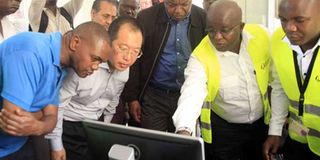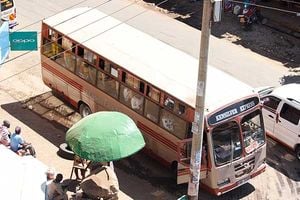Technology easing cargo clearance

Kenya Revenue Authority KRA Image Analyst Isaac Njoka (second right) shows the authority's Commissioner General John Njirani and other guests how scanner machines work within the port of Mombasa in this picture taken on August 25, 2017. PHOTO | LABAN WALLOGA | NATION MEDIA GROUP
What you need to know:
- This equipment is necessary to inspect high-risk cargo and/or transport conveyances quickly.
- KRA is installing Smart Gate Technology at the points of entry to automate the capture of container and vehicle registration marks.
The World Trade Organisation (WTO) forecasts that global trade will rise by 3.6 per cent by the end of the year.
Sea transport will continue to play a key role in this growth, given that nearly 90 per cent of all goods in the world are transported by sea.
However, this rapid growth in international trade and cargo volumes, travellers and conveyances presents increasingly new challenges.
They include security threats of terrorism, illegal trade in natural resources, trade in substances that pose a threat to public health and safety, illicit financial flows (money laundering) as well as piracy.
TRADE AND TRAVEL
Customs administrations and other players in the global supply chain need to continuously build and upgrade the capacity to handle the increased volumes and travel whilst enhancing security.
This calls for a balance between facilitation of trade and travel, and enforcement of controls to safeguard public safety.
Cargo inspection is a critical aspect in safeguarding the supply chain, security and protection of society against the organised transnational crimes of terrorism, hazardous substances and environmental crimes, and facilitation of legitimate trade.
For the past 15 years, the Kenya Revenue Authority (KRA) has used modern cargo inspection tools such as X-ray cargo scanning at the Mombasa seaport and airport.
The use of non-intrusive inspection equipment is consistent with the World Customs Organisation’s (WCO) Safe Framework of Standards, which states “that non-intrusive inspection equipment and radiation detection equipment should be available and used for conducting inspections, and in accordance with risk assessment.
This equipment is necessary to inspect high-risk cargo and/or transport conveyances quickly, without disrupting the flow of legitimate trade”.
The recent commissioning of three additional scanners, donated by China at the Port of Mombasa is a major milestone in sealing revenue leakages and in the fight against importation and exportation of restricted and prohibited goods.
X-RAY
The launch and deployment of the scanners will increase the port’s throughput capacity to scan up to 1,000 containers per day, while increasing considerably the KRA assets under the National Scanner Solution framework.
Kenya serves as the gateway to East and Central Africa through Mombasa port, which is both a transport and logistics hub for the Northern Corridor. In 2015/2016, the X-ray cargo scanning unit made a number of high-profile interceptions.
At one point, nine top-of-the range vehicles concealed as bicycles and toys from the United Kingdom and in transit to Uganda were intercepted. Investigations unearthed more vehicles, which had been registered irregularly and the culprits were brought to book.
Over 20 containers of new garments disguised as cold rooms as well as three containers of milk powder disguised as gypsum boards, undeclared electronics, spare parts, ivory and sandalwood, were also intercepted.
The scanners have also helped to prevent dumping of cheap, substandard and harmful products in the local market.
The KRA expects to receive another 10 baggage scanners from China for use in the airport terminals to boost customer facilitation.
FREIGHT STATIONS
In addition, the KRA is installing Smart Gate Technology at the points of entry to automate the capture of container and vehicle registration marks and numbers prior to the release of cargo from the ports and container freight stations, phasing out manual processes and enhancing the integrity of cargo release records.
Other initiatives such as the implementation of the Single Customs Territory, the Regional Electronic Cargo Tracking System (Rects) and the Integrated Customs Management System (ICMS), will reduce the cargo dwell time at the port.
The enhanced systems will also significantly reduce the time taken to transport cargo to inland container depots and neighbouring countries.
It will make the port more competitive and promote economic growth in the region and internationally.
Granted, states will always be under pressure from stakeholders to expedite the clearing and movement of goods from ports and other border posts to minimise the cost of doing business.
The rise in maritime traffic will continue generating the demand for advanced technology for handling cargo through sea and land borders and, to this end, the scanning technology will remain a critical tool now and in the future.
Mr Musyoki is the commissioner for Customs and Border Control at the Kenya Revenue Authority. [email protected]




